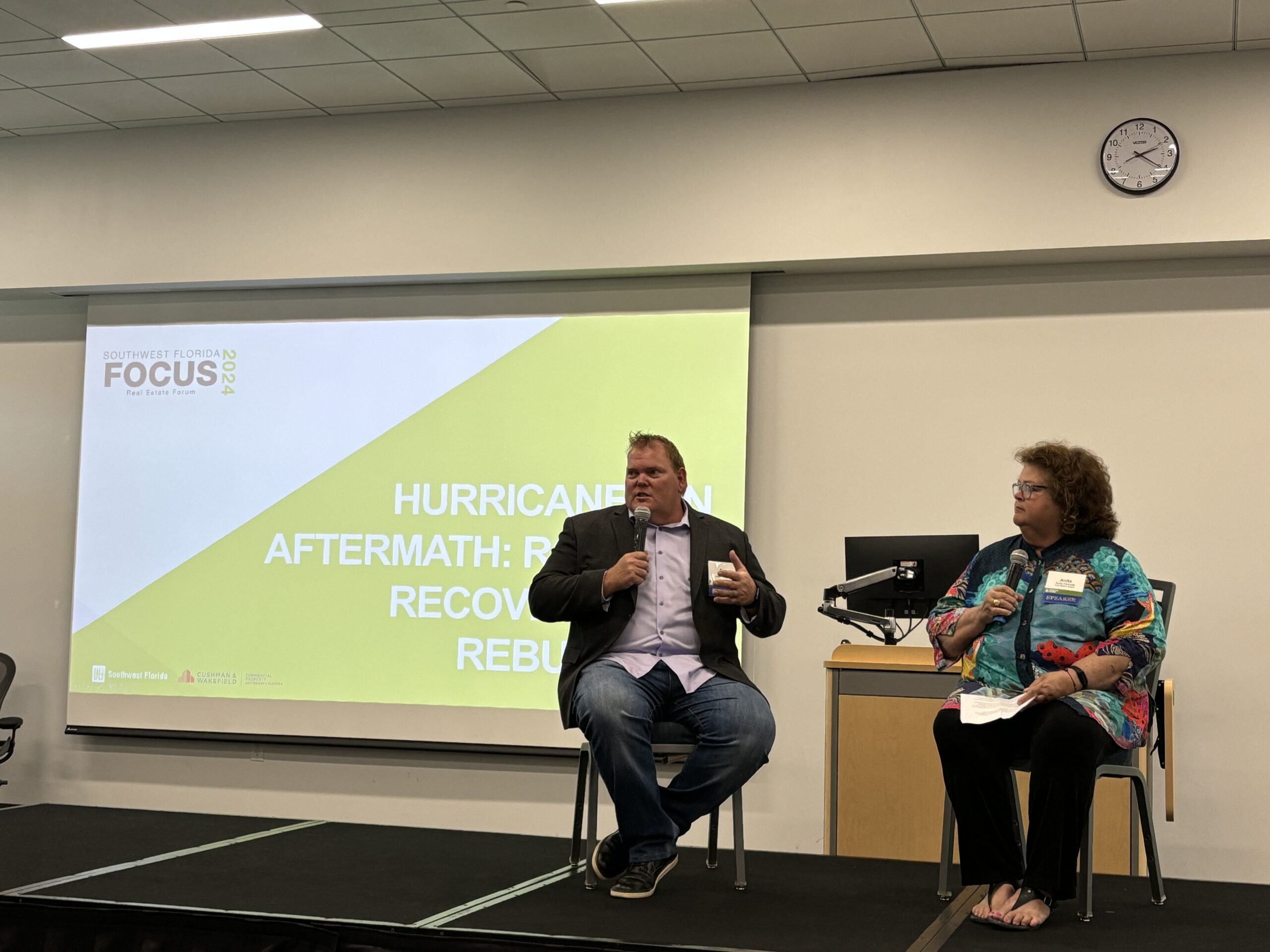Three developers with longtime Southwest Florida roots plan to make public access part of their projects as they work to rebuild Fort Myers Beach.
This was one of the many takeaways from a four-hour Urban Land Institute seminar featuring 14 guest speakers Feb. 22 at Florida Gulf Coast University’s Water School building.
About 150 people attended the Southwest Florida Real Estate Forum.
The seminar began with Fort Myers Beach Mayor Dan Allers and former Local Planning Agency Chair Anita Cereceda discussing the future of their town and the trauma of having endured Hurricane Ian on Sept. 28, 2022.
“It’s been 512 days since Hurricane Ian,” Cereceda said. “Not that I keep count, but I do.”
They discussed the lessons learned from the town following what they called the “chaos” of the storm’s immediate aftermath. The town is working to be better prepared for future storms, Allers said.
“When you think you are prepared, prepare some more,” he said. “Try to think outside the box.”
They also talked about their hopes for future projects to be inclusive to all economic sectors.
Beach developers talk future projects
Ben Freeland, CEO of Freeland Management; Matt Price, CEO of Seagate Development Group; and Mark Wilson, president of London Bay Homes; then shared the stage in discussing the beach’s future in a conversation moderated by Gulfshore Business Senior Editor Tim Aten.
“Now we see what storm surge looks like,” Freeland said. “And we know we need to build higher, stronger, bigger. These bigger structures are going to have to be bigger to withstand what the future holds.”
The hurricane accelerated what would have been an inevitable rebuild of the beach, he said.
“It would have taken 10 to 30 years,” Freeland said. “Now, you are going to see it in five to 10 years.”
“Let’s go back to the word ‘resiliency,’” Wilson said. “We’re not really building for today. We’ve got to try and build for future generations. We’ve got to be very cognizant of what the island will look like in 20, 30, 40 years.”
Price talked about creating diversity in architecture. Just because the buildings need to be more fortified—wooden cottages aren’t coming back—they don’t need to all look like parking garages either.
“How do you create viewing corridors when you have to build elevated buildings?” Price said of the challenges they share when designing the new developments. “There are ways to do that. But you have to make the math work.”
The three of them said they have been up front with the public. They will be looking to trade public benefit for deviations from established land codes.
“The only way to bring this back is with scale,” Wilson said.
Development in Charlotte, Collier, Lee
The forum then featured individual presentations by Kenny Siggs, executive vice president of Christopher Alan Homes; Pat Utter, senior vice president of real estate for Collier Enterprises; and Jim Zboril, president and CEO of L&L Development Group.
Siggs talked about the growth of Christopher Alan Homes, which in addition to building on infill lots, is doing a planned community, Creekside Run at Babcock Ranch.
“We did concrete and framing,” Siggs said of how his company got started. “As we were going through the process, we decided to build homes ourselves. In 2017, we closed on eight homes.”
This year, the company is building 331 homes, with 598 lots in the pipeline for the future.
“We’re really pushing the envelope as far as incorporating the master planned development with the environment,” Siggs said.
Zboril discussed his plans to build Coral Grove Town Center off Pine Island Road, on vacant land located behind Bubba’s Roadhouse and Saloon in Cape Coral.
“This is where the new growth is happening in Cape Coral,” Zboril said. “We looked at this as an opportunity to do a mixed-use concept.”
The plan is to build 1,250 apartment units with 350,000 square feet of retail and 150,000 square feet of office space and a hotel, all on about 130 acres.
“We have a good mix of tenants from entertainment and restaurants and bars,” Zboril said. “We have a fitness center. We’re working on a grocery.”
The renderings show a large courtyard in the middle and other green space.
“What’s really important is the space between the buildings,” he said. “The space between the buildings is where all the entertainment gets held. We can do car shows and concerts and things like that. It’s all important for people to want to come there and spend time and spend their money.
“This project, we’re hoping to get under way about this time next year.”
Utter discussed Collier Enterprise’s plans to build the Town of Big Cypress.
“Our projects typically take 20 years to permit,” he said.
“We’re slightly smaller than Ave Maria and slightly to the west,” Utter said of the location. “We’re saving all the trees, about 13,000 acres of pristine Cypress trees.”
The homes, almost 10,000 of them, will be built on laser-leveled former farms.
“Four major national builders are under contract,” he said.
The project faces another delay because of a federal court ruling that state approvals to build there violated the Endangered Species Act.
Utter said he still expected his development to occur.
“Our preserves, if you can combine them, it connects the corridor,” Utter said, referring to the land allowing panthers to roam. “That corridor is the connection between Corkscrew and the Panther preserve.”
 Growing trends in health care
Growing trends in health care
Scott Burgess, CEO of David Lawrence Centers for Behavioral Health, moderated a three-panelist discussion of the future of regional health care. David Kistel, vice president and chief facilities executive at Lee Health; Jonathan Kling, Chief Operations Officer at NCH Healthcare System; and Trent Lewis, director of facilities and corporate infrastructure at Arthrex comprised the panel.
“We’re integrating within the developments that are happening and making sure we have clinical spaces to serve all throughout the county,” Kistel said, meaning Lee County. “We’re looking at what’s happening in north Cape Coral.”
The three talked about the challenges of retaining employees following a rise in housing costs.
“It’s definitely a big challenge,” Lewis said. “One of the things that happened, especially going through Covid, was the shortage of day care facilities, especially in Collier County. One of the things we’re doing is building a day care, early learning center on our Naples campus. That’s one way we have to attain and retain and attract talent.”
Emerging trends 2024
Larry Buckner, manager of Zonda, a data-based real estate company, and Gary Tasman, CEO of Cushman & Wakefield Commercial Property of Southwest Florida, capped the forum with individual presentations that were heavy with data.
The Cape Coral-Fort Myers metro area ranked fourth in the country for net migration, Buckner said.
“Cape Coral-Fort Myers is interesting,” he said. “If you were to compare it with the other submarkets, they are actually among the most affordable in Florida.”
That said, resales of existing homes are not faring well, he said.
“Active listings have increased 66% from 2023 to 2024,” Buckner said. “This is a trend we have to keep in mind moving forward.
These homes are sitting on the market for about 60 days. Interest rates have to fall significantly, which I do not see happening any time soon. Or we have to see some significant price decreases.”
Another trend is remote work is here to stay, Buckner said, with 62% of companies still offering remote work possibilities.
Gary Tasman capped the forum talking about development trends. He said the region is not heading for a “doom loop,” meaning the downside of a real estate business cycle.
“There’s no doom loop coming to Southwest Florida any time soon,” Tasman said. He expected sales velocity to improve by the end of 2025.
Until then, so much money is flowing into the region to rebuild from Hurricane Ian, that a soft landing instead of a recession seems more likely, Tasman said.
There is $60 billion to $110 billion in total rebuild value over the next five years related to Hurricane Ian, Tasman said.
“When considering the ripple effect that construction spending has on our economy, there is absolutely no doubt in my mind that our expansion will continue and will bring with it strong job creation and population growth,” Tasman said. “The data suggests that Southwest Florida will lead the state and the country in economic expansion and opportunity for the foreseeable future.”





